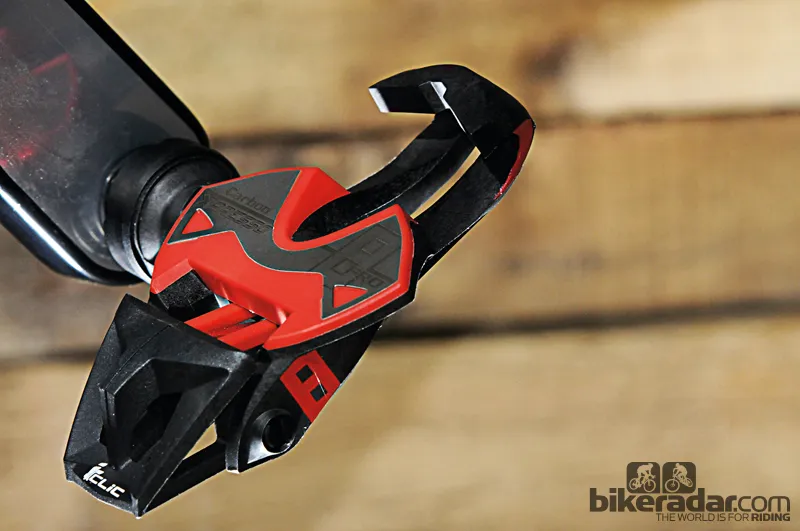Time was among the first pedal manufacturers to introduce knee-friendly float, and the company have continued to evolve their designs, from the old Racers to the RXS, then iClic. This new Xpresso range is designed to supersede the iClic.
Over the years the original two-part metal cleats gave way to a half-metal system within a plastic cleat, and then to a fully plastic cleat with a triangular pontoon surround for stability and protection. Any iClic users will be pleased to hear that this final design remains virtually unchanged for the new Xpresso pedals, and older cleats will fit.
So just what is new with the Xpresso, then? Well, instead of a steel spring that remains closed, the Xpresso has a carbon leaf spring that defaults to the open position, as used on the iClic, but just about everything else has been tweaked.

Engagement on the Xpresso pedal requires very little force, as the latch is pre-sprung like a mousetrap
Perhaps most noticeable is the increased platform size of 700mm² – up considerably from 445mm² – for a greater shoe contact area and more pedalling stability. Four of the five Xpresso models also include a replaceable stainless steel plate to protect the body from wear.
Even though the size of the pedal has been increased, Time have still managed to reduce their weight, thanks to the use of hollow steel axles and less carbon. The result is that the Xpresso 8s weigh just 198g per pair, compared with 257g for the equivalent iClic2 Racers they replace.

The engagement point on the cleat, at center, is well recessed from the rubber walking pads
What’s impressive is that Time’s entry level Xpresso 2 has all this technology (with a composite leaf spring) and weighs a scant 220g – for just £42.99/$75. The four models from the Xpresso 4 upwards have a carbon leaf spring, the major differences being the axles, with the hollow titanium of the range-topping Xpresso 12 bringing its weight down to 155g.
One downside of the Xpresso 8 Carbon's lightweight — and the absence of a heavy metal engagement spring -— is that the rear of the pedal often does not drop for easy entry. This means that we often had to look down and paw at the pedal before clipping in.

The pedal body is so light that it often didn't drop at the rear like a Shimano or Look
A letter ‘Q’ on one side of each cleat denotes the two possible Q-factors – the distance between the pedals – managed by fitting the cleats on different sides. There’s also 2.5mm of lateral float and /- 5 degrees of angular float, adjusted by an eccentric triangular cam against the carbon blade.
Though the cleats are the same as the iClic 2’s, pedal entry is faster, with an immediate, positive click and none of the phantom engagements common with the previous model. When climbing or sprinting hard out of the saddle, the Xpressos are incredibly stable and secure, and their 15-degree release angle makes accidental release in the heat of battle virtually impossible.

The carbon leaf spring replaces the traditional metal spring for engagement
This article was originally published in Cycling Plus magazine, available on Apple Newsstand and Zinio.











